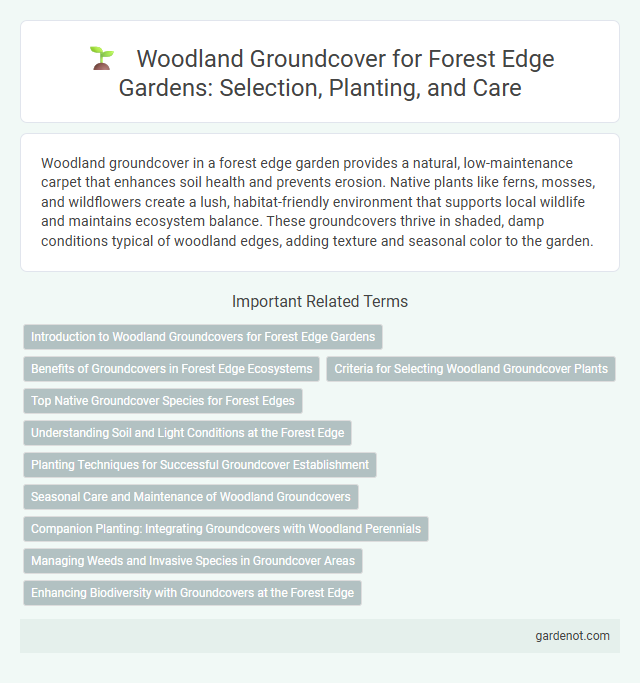Woodland groundcover in a forest edge garden provides a natural, low-maintenance carpet that enhances soil health and prevents erosion. Native plants like ferns, mosses, and wildflowers create a lush, habitat-friendly environment that supports local wildlife and maintains ecosystem balance. These groundcovers thrive in shaded, damp conditions typical of woodland edges, adding texture and seasonal color to the garden.
Introduction to Woodland Groundcovers for Forest Edge Gardens
Woodland groundcovers thrive in shaded, moist environments typical of forest edge gardens, offering low-maintenance, natural-looking plant layers that protect soil and suppress weeds. Popular species like wild ginger (Asarum canadense), foamflower (Tiarella cordifolia), and trillium add texture and seasonal interest while enhancing biodiversity. These groundcovers improve forest edge ecosystems by supporting native pollinators and promoting soil health through organic matter accumulation.
Benefits of Groundcovers in Forest Edge Ecosystems
Woodland groundcovers play a crucial role in forest edge ecosystems by enhancing soil stability and reducing erosion through dense root networks. These plants improve biodiversity by providing habitat and food sources for insects, birds, and small mammals, fostering a balanced micro-ecosystem. Groundcovers also aid in moisture retention and nutrient cycling, supporting the health and resilience of the forest edge environment.
Criteria for Selecting Woodland Groundcover Plants
Woodland groundcover plants must thrive in shaded, moist environments typical of forest edges, requiring species that tolerate low light and acidic, well-drained soil. Selecting plants with deep root systems ensures soil stabilization and prevents erosion along forest boundaries. Native species such as ferns, wild ginger, and trilliums enhance biodiversity, support local wildlife, and maintain ecological balance in woodland gardens.
Top Native Groundcover Species for Forest Edges
Woodland groundcovers like wild ginger (Asarum canadense), foamflower (Tiarella cordifolia), and bloodroot (Sanguinaria canadensis) thrive at forest edges by providing dense, low-growing foliage that helps prevent soil erosion and suppress invasive weeds. These native species are adapted to shaded environments and support local biodiversity by offering habitat and food sources for pollinators and wildlife. Selecting native groundcovers for forest edges ensures ecological balance and promotes sustainable landscape management.
Understanding Soil and Light Conditions at the Forest Edge
Woodland groundcover thrives in well-drained, nutrient-rich soils with high organic matter typically found at the forest edge. Light conditions vary from dappled shade to partial sunlight, influencing the selection of shade-tolerant species such as wild ginger and foamflower. Understanding these soil moisture levels and light gradients is essential to establish a resilient, naturalistic groundcover layer in forest edge gardens.
Planting Techniques for Successful Groundcover Establishment
Effective planting techniques for woodland groundcover involve selecting native shade-tolerant species such as wild ginger, mayapple, and trillium to ensure ecological compatibility and robust growth. Preparing the soil by clearing debris and loosening the top layer enhances root penetration and moisture retention critical for successful establishment. Mulching with organic materials like leaf mold mimics natural forest conditions, suppresses weeds, and maintains consistent soil humidity for optimal groundcover development.
Seasonal Care and Maintenance of Woodland Groundcovers
Woodland groundcovers require seasonal care and maintenance to thrive along forest edges, including mulching in fall to protect roots from winter cold and controlling invasive weeds in spring to reduce competition. Regularly monitoring soil moisture and ensuring adequate shade mimic their natural habitat, promoting healthy growth throughout the growing season. Removing dead foliage in late winter improves airflow and prepares the groundcover for vigorous spring regeneration.
Companion Planting: Integrating Groundcovers with Woodland Perennials
Woodland groundcovers such as wild ginger, foamflower, and creeping phlox create a lush carpet that suppresses weeds and retains soil moisture in forest edge gardens. Integrating these groundcovers with woodland perennials like trilliums, hostas, and ferns enhances biodiversity and promotes healthy ecosystem interactions. Strategic companion planting improves nutrient cycling and offers habitat diversity for pollinators and beneficial insects, supporting a resilient garden microenvironment.
Managing Weeds and Invasive Species in Groundcover Areas
Effective management of weeds and invasive species in woodland groundcover areas involves regular monitoring and early removal to prevent their spread and preserve native plant health. Utilizing mulch barriers and selective herbicides can reduce weed growth without harming desirable groundcover species. Promoting a diverse and dense planting of native plants enhances competition against invasives, maintaining a balanced ecosystem at the forest edge garden.
Enhancing Biodiversity with Groundcovers at the Forest Edge
Woodland groundcovers such as wild ginger, trilliums, and mosses play a crucial role in enhancing biodiversity at the forest edge by providing habitat and food sources for native insects and small mammals. These low-growing plants improve soil health by preventing erosion and promoting moisture retention, which supports the growth of shade-tolerant trees and shrubs. Incorporating diverse groundcovers increases ecosystem stability and encourages the natural regeneration of native woodland species.
Woodland groundcover Infographic

 gardenot.com
gardenot.com